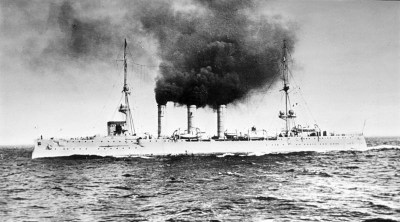The Battle of Cocos was a single-ship action that occurred on 9 November 1914, after the Australian light cruiser HMAS Sydney (under the command of John Glossop) responded to an attack on a communications station at Direction Island by the German light cruiser SMS Emden (commanded by Karl von Mller).
After the retreat of the German East Asia Squadron from Southeast Asia, Emden remained behind to function as a commerce raider. During a two-month period, the German cruiser captured or sank 25 civilian vessels, shelled Madras, and destroyed two Allied warships at Penang. In early November, von Mller decided to attack the communications station at Direction Island, in the Cocos (Keeling) Islands, to hamper Allied communications and frustrate the search for his ship. Around the same time, a convoy of Europe-bound transports carrying Australian and New Zealand soldiers departed from Albany, Western Australia, with HMAS Melbourne, HMAS Sydney, HMS Minotaur, and Japanese battlecruiser Ibuki escorting.
During the night of 89 November, Emden reached the islands, and sent a party ashore at around 06:00 to disable the wireless and cable transmission station on Direction Island. The station was able to transmit a distress call before it was shut down. Melbourne received the message, and ordered Sydney to investigate. The Australian ship arrived off Direction Island at 09:15, spotting and being spotted by Emden; both ships prepared for combat. Emden opened fire at 09:40, surprising those aboard Sydney as the range was greater than British intelligence thought Emden was capable of. The German ship scored several hits, but was unable to inflict disabling damage to the Australian cruiser before Sydney opened up with her more powerful main guns. At 11:20, von Mller ordered that the heavily damaged Emden beach on North Keeling Island. The Australian warship broke to pursue the collier Buresk, which scuttled herself, then returned to North Keeling Island at 16:00. At this point, Emden's battle ensign was still flying, and after no response to instructions to lower the ensign, Glossop ordered two salvoes shot into the beached cruiser. Sydney had orders to ascertain the status of the transmission station, but returned the next day to provide medical assistance to the Germans.
Of Emden's crew, 134 were killed and 69 wounded, compared to only 4 killed and 16 wounded aboard Sydney. The German survivors were taken aboard the Australian cruiser, with most transferred to auxiliary cruiser Empress of Russia on 12 November. Sydney rejoined the troop convoy in Colombo, then spent the rest of the war assigned to the North America and West Indies Station, then the British Grand Fleet. Von Mller and some of his officers were imprisoned in Malta, and the rest of the German personnel were sent to prisoner-of-war camps in Australia. An additional 50 German personnel from the shore party, unable to be recovered before Sydney arrived, commandeered a schooner and escaped from Direction Island, eventually arriving in Constantinople. The defeat of the last German ship in the region allowed RAN warships to be deployed to other theatres, and troopships were able to sail unescorted between Australia and the Middle East until renewed raider activity in 1917.
SMS Emden ("His Majesty's Ship Emden") was the second and final member of the Dresden class of light cruisers built for the Imperial German Navy (Kaiserliche Marine). Named for the town of Emden, she was laid down at the Kaiserliche Werft (Imperial Dockyard) in Danzig in 1906. The hull was launched in May 1908, and completed in July 1909. She had one sister ship, Dresden. Like the preceding Königsberg-class cruisers, Emden was armed with ten 10.5 cm (4.1 in) guns and two torpedo tubes.
Emden spent the majority of her career overseas in the German East Asia Squadron, based in Tsingtao, in the Kiautschou Bay concession in China. In 1913, Karl von Müller took command of the ship. At the outbreak of World War I, Emden captured a Russian steamer and converted her into the commerce raider Cormoran. Emden rejoined the East Asia Squadron, then was detached for independent raiding in the Indian Ocean. The cruiser spent nearly two months operating in the region, and captured nearly two dozen ships. On 28 October 1914, Emden launched a surprise attack on Penang; in the resulting Battle of Penang, she sank the Russian cruiser Zhemchug and the French destroyer Mousquet.
Müller then took Emden to raid the Cocos Islands, where he landed a contingent of sailors to destroy British facilities. There, Emden was attacked by the Australian cruiser HMAS Sydney on 9 November 1914. The more powerful Australian ship quickly inflicted serious damage and forced Müller to run his ship aground to avoid sinking. Out of a crew of 376, 133 were killed in the battle. Most of the survivors were taken prisoner; the landing party, led by Hellmuth von Mücke, commandeered an old schooner and eventually returned to Germany. Emden's wreck was quickly destroyed by wave action, and was broken up for scrap in the 1950s.

1914Nov, 9
SMS Emden is sunk by HMAS Sydney in the Battle of Cocos.
Choose Another Date
Events on 1914
- 28Jun
Assassination of Archduke Franz Ferdinand of Austria
Archduke Franz Ferdinand of Austria and his wife Sophie are assassinated in Sarajevo; this is the casus belli of World War I. - 26Jul
Bulgaria
Serbia and Bulgaria interrupt diplomatic relationship. - 5Aug
Traffic light
In Cleveland, Ohio, the first electric traffic light is installed. - 15Aug
Frank Lloyd Wright
A servant of American architect Frank Lloyd Wright murders seven people and sets fire to the living quarters of Wright's Wisconsin home, Taliesin. - 1Sep
Petrograd
St. Petersburg, Russia, changes its name to Petrograd.

 English
English  español
español  français
français  português
português  русский
русский  العربية
العربية  简体中文
简体中文 